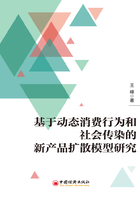
本章参考文献
[1]常莹,李季,王汉生,涂平.具备重复购买机制的新产品扩散模型:理论模型与非线性最小一乘估计[J].营销科学学报,2006,2(4):22-31.
[2]何佳,曾勇.技术创新速度对新技术购买行为的影响——两代未来创新的情况[J].管理科学学报,2003(1):13-19.
[3]李锋,魏莹.双寡头竞争环境下新产品扩散的仿真分析[J].工业工程与管理,2019,24(3):147-156.
[4]李英,黄海梁,李莹莹.异质性视角下考虑客户流失的服务类产品扩散研究[J].系统管理学报,2017,26(3):456-463.
[5]王展昭,马永红,张帆.基于系统动力学方法的技术创新扩散模型构建及仿真研究[J].科技进步与对策,2015,32(19):13-19.
[6]王展昭.考虑重复购买因素的品牌竞争对新产品扩散的影响研究——基于小世界网络的仿真环境[J].中国管理科学,2019,27(12):164-174.
[7]赵正龙,陈忠,孙武军,李莉.具有差异化选择特征的复杂社会网络扩散研究[J].管理科学学报,2010,13(3):38-49.
[8]庄新田,黄玮强.基于消费者网络的金融创新扩散研究[J].管理科学学报,2009,12(3):132-141.
[9]ATAMAN M, MELA C. Building brands [J]. Marketing Science, 2008, 27 (6): 1036-1054.
[10]BASS F M. A new product growth model for consumer durables [J]. Management Science, 1969, 29 (3): 215-227.
[11]BASS F M. Comments on“A new product growth for model consumer durables”: The bass model [J]. Management Science, 2004, 50 (12): 1833-1840.
[12]BASS F M, KRISHNAN R, JAIN A. Why the bass model fits without decision variables [J]. Marketing Science, 1994, 13 (3): 203-223.
[13]BILLIE JO Z, MODESTO A M. A model of new product development: Anempiricaltest [J]. ManagementScience, 1990, 36 (7): 867-883.
[14]BOLTON R. A dynamic model of the duration of the customer's relationship with a continuous service provider: The role of satisfaction [J]. Marketing Science, 1998, 17 (1): 45-65.
[15]BOOZ, ALLEN, HAMILTON. New product development in the 1980s [M]. New York: Booz, Allen & Hamilton, 1982.
[16]GARBER T, GOLDENBERG J, LIBAI B, MULLER E. From density to destiny: Using spatial dimension of sales data for early prediction of new product success [J]. Marketing Science, 2004, 23 (3): 419-428.
[17]GOLDENBERG J, LIBAI B, MULLER E. Riding the saddle: How cross-market communications can create a major slump in sales [J]. Journal of Marketing, 2002, 66 (2): 1-16.
[18]GUPTA A, JAIN D, C, SAWHNEY M, S. Modeling the evolution of markets with indirect network externalities: An application to digital television [J]. Marketing Science, 1999, 18 (3): 396-416.
[19]GUSTAFSSON A, JOHNSON M D. The effects of customer satisfaction, relationship commitment dimensions, triggers on customer retention [J]. Journal of Marketing, 2005, 69 (4): 210-218.
[20]HAHNM, PARKS, KRISHNAMURTHIL, ZOLTNERSA A. Analysis of new product diffusion using a four-segment trial-repeat model [J]. Marketing Science, 1994, 13 (3): 224-247.
[21]INMAN J J, ZEELENBERG M. Regret in repeat purchase versus switching decisions: The attenuating role of decision justifiability [J]. Journal of Consumer Research, 2002, 29 (1): 116-128.
[22]KILANI M. Evolution and the complexity of finite automata [J]. International Game Theory Review, 2007, 9 (4): 731-743.
[23]LIANG C-J, WANG W-H. Attributes, benefits, customer satisfaction and behavioral loyalty——an integrative research of financial services industry in Taiwan [J]. Journal of Services Research, 2004, 4 (1): 57-91.
[24]LLIBAI B, MULLER E, PERES R. The diffusion of services [J]. Journal of Marketing Research, 2009, 46 (2): 163-175.
[25]LUO X. Consumer negative voice and idiosyncratic stock returns [J]. Journal of Marketing, 2007, 71 (3): 75-88.
[26]PERES R, MULLER E, MAHAJAN V. Innovation diffusion and new product growth: Critical review and research directions [J]. International Journal of Research in Marketing, 2010, 27 (2): 91-106.
[27]RADAS S, SHUGAN S M. Seasonal marketing and timing new product introductions [J]. Journal of Marketing Research, 1998, 35 (3): 296-315.
(1) 有关新产品的概念很宽泛,本书做如下说明:第一,为表达简洁,本书使用“产品”一词涵盖产品或服务。第二,有些文章将新产品扩散和创新扩散的概念混合使用,但新产品(New Product)与创新(Innovation)是有区别的。创新的范围更广,不仅包括新产品,还包括新方法、新思想、新制度、新流程等。本书仅讨论有关产品方面的创新。第三,新产品在市场营销学、经济学以及工程学中均有不同的定义。本书从市场营销学的角度来界定。产品在任何一个维度上的变革和创新,并给消费者带来新的价值和满足的产品,都是一种新产品。Booz、Allen和Hamilton(1982)从“对公司的新颖程度”和“对市场的新颖程度”两个维度来划分6种类型的新产品。全新产品指能够开创新市场的新产品;新产品线指企业首次进入已建立市场的新产品;现行产品线的增补品指企业在已建立的产品线上增补的新产品(如新包装、新口味、新规格);现行产品的改进更新指提供改进性能和较大改变价值的并替代现有产品的新产品;市场重定位指以新的或细分市场为上市目标的新产品;成本降低型新产品指通过降低产品成本,从而生产出相似类型的新产品。然而,沿袭新产品扩散领域的研究,本书的研究目的不在于对这6种类型新产品做深入区分,而在于讨论营销学概念上的新产品在上市后消费者的采用特征以及新产品的扩散规律。第四,新产品扩散的研究主要有两个层面:产品品类层面(Category-level)和品牌层面(Brand-level)。本书在第5章将构建品类层面和品牌层面的模型,但是为了与现有模型做对比,第6章和第7章的实证部分都将聚焦于品类层面的新产品扩散模型的构建与实证计量分析。